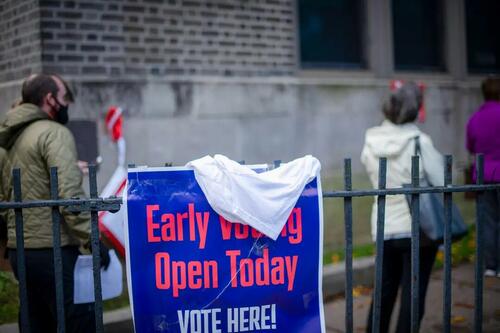
Authored by Samantha Flom via The Epoch Times (emphasis ours),
With just weeks to go until the general election, election offices across the country are making their final preparations, and in some cases, accepting ballots.
Here are the answers to some common questions voters may have as they gear up to cast their ballots.

When Is Election Day?
Election Day is Tuesday, Nov. 5.
Who Can Vote?
Only U.S. citizens ages 18 or older are permitted to vote in federal elections.
Can I Vote Early?
That depends on your state.
Most states offer early or absentee voting for any reason, though a few (Alabama, Mississippi, and New Hampshire) require voters to meet certain eligibility requirements.
To vote absentee, you will need to request a ballot before your state’s deadline unless you live in one of a handful of states that automatically mail out ballots to all voters.
Those states include California, Colorado, Hawaii, Nevada, Oregon, Utah, Vermont, Washington, and the District of Columbia, which allow all elections to be conducted by mail.
You can check your eligibility and request an absentee ballot through your local election office or via Vote.org. Ballots can be returned via mail, in-person at your local election office, or via a drop box, if your state uses them.
In most states, you can track the status of your absentee ballot online. Some may also offer text or email alerts to keep you updated as your ballot is processed.
Early in-person voting is also available in most states, though dates vary. Check this calendar to see when early voting begins and ends in your state.

What Do I Need to Do?
The first step to voting—early or otherwise—is to make sure you are registered. All states and territories, save North Dakota, require voters to register.
You can check the status of your voter registration here. Online registration is also available up until your state’s deadline.
Most states also either require or request that voters present some form of ID to vote in person, though rules vary.
In some cases, voters may be allowed to vote without any form of identification. Check your state’s requirements here.
Lastly, before heading to the polls, verify your polling location and the hours it will open with your local elections office.
What Are the Top Races?
With control of the House, Senate, and White House up for grabs, there are many races on this year’s ballot that could prove critical to the balance of power in Washington.
Democrat Vice President Kamala Harris is seeking a promotion to the role of president, while former President Donald Trump, the Republican nominee, is hoping to secure a second term.
Their running mates, Minnesota Gov. Tim Walz and Sen. JD Vance of Ohio will also be on the ballot.

On Capitol Hill, Republicans’ control of the House and the Democrat majority in the Senate are both hanging by a thread.
With all 435 House seats up for election, Democrats need only flip four to take control of the chamber.
New York’s 4th Congressional District is one place they are eyeing for a gain.
There, freshman Rep. Anthony D’Esposito, a Republican, is defending his seat against Democrat Laura Gillen, former Hempstead town supervisor, in a rematch of 2022.
The race for Arizona’s 1st District seat, currently held by Republican Rep. David Schweikert, is another where Democrats could pull off an upset.
Schweikert won the district by about 3,200 votes in 2022—a thin margin that could bode well for his Democrat challenger, former state Rep. Amish Shah.
Republicans, on the other hand, are hoping to expand their majority by flipping Maine’s 2nd Congressional District, where former NASCAR driver and Republican state lawmaker Austin Theriault is taking on three-term Democrat Rep. Jared Golden.
Pennsylvania’s 8th District is also on Republicans’ radar.

Trump carried the district twice, and with the 45th president on the ballot again, Democrat Rep. Matt Cartwright could lose his seat to Republican businessman Rob Bresnahan.
In the Senate, Republicans are targeting the seats of several vulnerable Democrats and independents in hopes of retaking the upper chamber.
One they are expected to win handily is the seat of West Virginia’s newly independent Sen. Joe Manchin, who is not seeking reelection.
Before Manchin’s affiliation change in May, he was West Virginia’s sole remaining Democrat in a statewide office.
Although he endorsed Wheeling’s Democrat Mayor Glenn Elliott to take his place, West Virginians are widely expected to pick Republican Jim Justice, the current governor, to fill the seat.
In Montana, another GOP stronghold, Democrat Sen. Jon Tester is in danger of losing his race against Republican Tim Sheehy, a former Navy SEAL and entrepreneur.
The latest RealClearPolitics average of polls shows Tester trailing his challenger by more than 5 points.

Ohio’s Democrat Sen. Sherrod Brown is in a similar position. He’s defending his seat against Trump-endorsed entrepreneur Bernie Moreno in another state that tends to lean Republican.
However, in that case, the RealClearPolitics average of polls favors Brown by 3.6 points.
Meanwhile, Sens. Ted Cruz (R-Texas) and Rick Scott (R-Fla.) are looking to stave off Democrat challengers in two reliably red states.
And the race to replace Arizona’s independent Sen. Kyrsten Sinema is also sure to be closely watched, with Trump ally and former gubernatorial candidate Kari Lake set to take on Democrat Rep. Ruben Gallego.
Other Senate battlegrounds include Michigan, Nevada, Pennsylvania, Maryland, and Wisconsin.

When Will We Know Results?
With the recent rise in the popularity of mail-in voting, it’s unlikely every race will be decided on election night.
Each state has different laws governing how long absentee ballots may be accepted and when election offices may start counting them.
Some states allow that process to begin before Election Day, whereas others require officials to wait until after the polls close.
Because of those rules, counting continued days past Election Day in many states in 2020, prompting questions about the accuracy and validity of the results.
The U.S. Postal Service encourages those voting by mail to mail their completed ballots before Election Day and at least one week before their state’s deadline to ensure their vote is counted.
The Associated Press contributed to this report.
Authored by Samantha Flom via The Epoch Times (emphasis ours),
With just weeks to go until the general election, election offices across the country are making their final preparations, and in some cases, accepting ballots.
Here are the answers to some common questions voters may have as they gear up to cast their ballots.

When Is Election Day?
Election Day is Tuesday, Nov. 5.
Who Can Vote?
Only U.S. citizens ages 18 or older are permitted to vote in federal elections.
Can I Vote Early?
That depends on your state.
Most states offer early or absentee voting for any reason, though a few (Alabama, Mississippi, and New Hampshire) require voters to meet certain eligibility requirements.
To vote absentee, you will need to request a ballot before your state’s deadline unless you live in one of a handful of states that automatically mail out ballots to all voters.
Those states include California, Colorado, Hawaii, Nevada, Oregon, Utah, Vermont, Washington, and the District of Columbia, which allow all elections to be conducted by mail.
You can check your eligibility and request an absentee ballot through your local election office or via Vote.org. Ballots can be returned via mail, in-person at your local election office, or via a drop box, if your state uses them.
In most states, you can track the status of your absentee ballot online. Some may also offer text or email alerts to keep you updated as your ballot is processed.
Early in-person voting is also available in most states, though dates vary. Check this calendar to see when early voting begins and ends in your state.

What Do I Need to Do?
The first step to voting—early or otherwise—is to make sure you are registered. All states and territories, save North Dakota, require voters to register.
You can check the status of your voter registration here. Online registration is also available up until your state’s deadline.
Most states also either require or request that voters present some form of ID to vote in person, though rules vary.
In some cases, voters may be allowed to vote without any form of identification. Check your state’s requirements here.
Lastly, before heading to the polls, verify your polling location and the hours it will open with your local elections office.
What Are the Top Races?
With control of the House, Senate, and White House up for grabs, there are many races on this year’s ballot that could prove critical to the balance of power in Washington.
Democrat Vice President Kamala Harris is seeking a promotion to the role of president, while former President Donald Trump, the Republican nominee, is hoping to secure a second term.
Their running mates, Minnesota Gov. Tim Walz and Sen. JD Vance of Ohio will also be on the ballot.

On Capitol Hill, Republicans’ control of the House and the Democrat majority in the Senate are both hanging by a thread.
With all 435 House seats up for election, Democrats need only flip four to take control of the chamber.
New York’s 4th Congressional District is one place they are eyeing for a gain.
There, freshman Rep. Anthony D’Esposito, a Republican, is defending his seat against Democrat Laura Gillen, former Hempstead town supervisor, in a rematch of 2022.
The race for Arizona’s 1st District seat, currently held by Republican Rep. David Schweikert, is another where Democrats could pull off an upset.
Schweikert won the district by about 3,200 votes in 2022—a thin margin that could bode well for his Democrat challenger, former state Rep. Amish Shah.
Republicans, on the other hand, are hoping to expand their majority by flipping Maine’s 2nd Congressional District, where former NASCAR driver and Republican state lawmaker Austin Theriault is taking on three-term Democrat Rep. Jared Golden.
Pennsylvania’s 8th District is also on Republicans’ radar.

Trump carried the district twice, and with the 45th president on the ballot again, Democrat Rep. Matt Cartwright could lose his seat to Republican businessman Rob Bresnahan.
In the Senate, Republicans are targeting the seats of several vulnerable Democrats and independents in hopes of retaking the upper chamber.
One they are expected to win handily is the seat of West Virginia’s newly independent Sen. Joe Manchin, who is not seeking reelection.
Before Manchin’s affiliation change in May, he was West Virginia’s sole remaining Democrat in a statewide office.
Although he endorsed Wheeling’s Democrat Mayor Glenn Elliott to take his place, West Virginians are widely expected to pick Republican Jim Justice, the current governor, to fill the seat.
In Montana, another GOP stronghold, Democrat Sen. Jon Tester is in danger of losing his race against Republican Tim Sheehy, a former Navy SEAL and entrepreneur.
The latest RealClearPolitics average of polls shows Tester trailing his challenger by more than 5 points.

Ohio’s Democrat Sen. Sherrod Brown is in a similar position. He’s defending his seat against Trump-endorsed entrepreneur Bernie Moreno in another state that tends to lean Republican.
However, in that case, the RealClearPolitics average of polls favors Brown by 3.6 points.
Meanwhile, Sens. Ted Cruz (R-Texas) and Rick Scott (R-Fla.) are looking to stave off Democrat challengers in two reliably red states.
And the race to replace Arizona’s independent Sen. Kyrsten Sinema is also sure to be closely watched, with Trump ally and former gubernatorial candidate Kari Lake set to take on Democrat Rep. Ruben Gallego.
Other Senate battlegrounds include Michigan, Nevada, Pennsylvania, Maryland, and Wisconsin.

When Will We Know Results?
With the recent rise in the popularity of mail-in voting, it’s unlikely every race will be decided on election night.
Each state has different laws governing how long absentee ballots may be accepted and when election offices may start counting them.
Some states allow that process to begin before Election Day, whereas others require officials to wait until after the polls close.
Because of those rules, counting continued days past Election Day in many states in 2020, prompting questions about the accuracy and validity of the results.
The U.S. Postal Service encourages those voting by mail to mail their completed ballots before Election Day and at least one week before their state’s deadline to ensure their vote is counted.
The Associated Press contributed to this report.
Loading…





